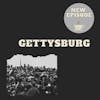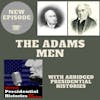Gettysburg

The bloodiest battle of the Civil War, Gettysburg was the fatal blow to Robert E. Lee's quest to invade the north and force a surrender.
Tune in as I describe how thousands of Union and Confederate soldiers overtook a small, rural community in southern Pennsylvania and how the battlefield became a public history site.
SOURCES
“Antietam.” American Battlefield Trust. (LINK)
“Biography: General Robert E. Lee.” American Experience. PBS. (LINK)
Bloom, Robert L. “‘WE NEVER EXPECTED A BATTLE’: THE CIVILIANS AT GETTYSBURG, 1863.” Pennsylvania History: A Journal of Mid-Atlantic Studies 55, no. 4 (1988): 161–200. http://www.jstor.org/stable/27773262.
Blount jr., Roy. “Making Sense of Robert E. Lee.” Smithsonian Magazine. July 2003. (LINK)
“George C. Meade.” National Park Service. (LINK)
“Gettysburg.” American Battlefield Trust. (LINK)
“Gettysburg National Cemetery: Gettysburg, Pennsylvania.” Civil War Era National Cemeteries. National Park Service. (LINK)
“Gettysburg Overview.” National Park Service. (LINK)
“Lee’s Letter to Winfield Scott.” National Park Service. (LINK)
Lincoln, Abraham, Pres. U. S. Gettysburg address delivered at Gettysburg Pa. Nov. 19th, . n. p. n. d. Pdf. https://www.loc.gov/item/rbpe.24404500/.
Pruitt, Sarah. “How the Battle of Gettysburg Turned the Tide of the Civil War.” July 1, 2019. History. (LINK)
“Robert Edward Lee.” National Park Service. (LINK)
We have come to dedicate a portion of that field as a final resting place for those who here gave their lives that that nation might live. It is altogether fitting and proper that we should do this. “But in a larger sense we cannot dedicate, we cannot consecrate, we cannot hallow this ground. The brave men, living and dead, who struggled here have consecrated it, far above our poor power to add or detract. The world will little note, nor long remember, what we say here, but it can never forget what they did here. It is for us the living, rather, to be dedicated here to the unfinished work which they who fought here have thus far so nobly advanced. Abraham Lincoln November 19, 1863.
Welcome to Civics and Coffee. My name is Alycia and I am a self-professed history nerd. Each week, I am going to chat about a topic on U.S history and give you both the highlights and occasionally break down some of the complexities in history; and share stories you may not remember learning in high school. All in the time it takes to enjoy a cup of coffee.
INTRO MUSIC
Hey everyone. Welcome back.
Over the course of three days in the summer of 1863, thousands of Americans converged upon a quiet, rural town in Pennsylvania. Several years into war, Confederate commander Robert E Lee hoped this attack of the north, his second in under a year, would be the final blow to the Union and convince President Lincoln to request peace.
Lee would be gravely mistaken. At the conclusion of the bloodiest battle of the Civil War, the Union remained intact and Lee’s Confederate forces were in retreat as over fifty thousand soldiers lay dead or injured. So many men and women were lost that day that a portion of the area was dedicated in their memory, prompting a visit from President Lincoln where he gave his famous Gettysburg Address.
Join me this week as I dive into the Battle of Gettysburg. What happened? Who was involved? And what were the ramifications?
Grab your cup of coffee, peeps. Let’s do this.
As I have put together these episodes covering the war, I have been mindful to avoid discussing too many of the battles in significant detail. I did this intentionally for several reasons. First, I am not someone who can easily track and understand battle terms and plans. Second, while military strategy is no doubt a fascinating topic, I find much more enjoyment in covering the human stories.
However, I knew going into this period of American history that there was little chance I would get out of covering Gettysburg. It is an iconic battle for a number of reasons and if memory serves, is one of the first battles I remembered learning about when the Civil War came up in the curriculum. This is likely because of the eventual address given by Lincoln and a result of its influence in turning the tide of the war, but I am still determined to cover it my way - through looking at the people - beginning with confederate commander Robert E. Lee.
The man who would go on to become known as one of the most capable and successful generals in military history, Robert E. Lee was born in Virginia in 1807. His father, Colonel Henry Lee was an officer in the Continental Army and a politician, serving in the House of Representatives before his son was born. However, the elder Lee was not a successful member of southern society, executing poor land deals and unable to manage his finances responsibly. WIthout means to attend university, Robert E. Lee enrolled into the United States Military Academy at West Point, where he thrived, graduating second in his class in 1829. Although there are debates about just how successful one should classify him, Lee was nothing if not a dedicated soldier, spending over thirty years as part of the armed services.
When Lee resigned his post in the army, he did so with a certain level of remorse, writing to his commanding officer quote: “I have felt that I ought not longer to retain any commission in the army. I therefore tender my resignation which I request you will recommend for acceptance. It would have been presented at once but for the struggle it has cost me to separate myself from a service to which I have devoted all the best years of my life and all the ability I possessed,” end quote.
After his resignation, Lee first commanded the forces from his home state of Virginia before Jeferson Davis asked him to assume control of the Confederate Army in 1862. As commander, Lee launched a series of successful offensive initiatives, driving Union forces backward. These victories perhaps gave Lee a false sense of confidence as he decided to try to force the Union’s capitulation by invading the north. The commander hoped that by bringing the battle north, union politicians would abandon the war effort and the Confederacy could convince European nations to lend their support, forcing a northern surrender. Lee’s first attempt was at Antietam in September of 1862. Facing George McClellan, over 22,000 soldiers died, making the battle the deadliest single day conflict of the war.
Despite the setback, Lee decided to try again, this time by invading Pennsylvania. Located just a few miles north of Maryland’s border, the town of Gettysburg was a quiet, rural community and was not prepared for the coming onslaught of military men. Lee initially overshot his movements, going beyond Gettysburg. Having the union troops to his south meant he risked losing access to supplies and so he made the decision to swing back around and try to take out the enemy.
Commanding the Union forces was George C. Meade. Also a graduate of Military Academy at West Point, Meade was born in Pennsylvania in 1815. He initially only served a year after graduating, hoping to pursue a private career, but when that was unsuccessful, Meade made the military his career. Meade’s command of the Army of the Potomac was still new when the first barrage of attacks came through. President Lincoln had grown frustrated with prior leader, Major General Joseph Hooker, and replaced him with Meade mere days before Gettysburg on June 28th. The main charge for Meade and his men was to act as a stop-gap between the Confederacy and D.C. Under no circumstances were they to allow the southern forces to break through. Little did they know how soon they’d be expected to fulfill their duties.
As the confederates moved closer toward town, they confiscated as many supplies as possible, including horses and cattle, and destroyed property as they marched forward. Despite this oncoming advancement, residents of Gettysburg were somehow still surprised when fighting commenced between union and confederate forces. For their part, local residents did what they could to support the union men coming through town, providing food and water to a tired set of men.
The Battle at Gettysburg was a three day affair and initially showed promise for the confederate side, who successfully managed to push the union forces into a defensive position. Part of their retreat necessitated riding through town where union men advised residents to go into hiding. One resident, a man named Albertus McCreary, later recalled he was told quote, “all you good people go down to your cellars or you will be killed,” end quote.
Confederate forces were successful again on day two, gaining important ground and giving Lee perhaps a false sense of confidence about his men’s ability to take the area. I say this because on day three Lee ordered his men to advance through an open, unprotected field. Known as Pickett’s Charge, the area provided zero cover, making the confederate soldiers sitting ducks for union fire. It proved to be a disastrous decision for Lee, who lost over five thousand men in just one hour.
The devastating loss prompted Lee to pull back and he commanded his forces to move back into the protections of southern territory. Lincoln, who hoped to take advantage of the reduced fighting force, wanted Meade to follow the confederates and strike the final blow to prompt Lee’s surrender. However, Meade decided to play it safe - a common theme among union commanders - and did not follow Lee or his men south. Lincoln was apparently angered over this lack of initiative, supposedly saying quote, “we had only to stretch forth our hands and they were ours,” end quote. Whether Meade would have been successful at overwhelming Lee’s men and securing a surrender remains one of the many what-ifs in history. Regardless, the war would extend another eighteen months and whatever small hope at victory quickly disappeared for the President.
Despite his frustration at not securing a surrender from the Confederacy, the Battle of Gettysburg was a turning point in the war. Robert E. Lee, who was coming off an impressive victory just months prior at the Battle of Chancellorsville, posed a mighty threat to the Union. He was aggressive in his war plans and was committed to trying to bring the union to its knees through invading the federal army on its home turf. If successful, Lincoln and the Union could have faced significant pressure to relent and negotiate a peace that would be arguably different than the final outcome. However, by repelling the invading forces, the Union not only secured a tactical victory, but enjoyed a morale boost as well. Despite the challenges and mighty command that was Robert E. Lee, federal troops held the line, destroying the General’s plans to overwhelm the north. Although fighting would continue for almost two more years, the Union proved that Lee was not as untouchable as they originally thought.
But the victory came at a significant cost. Over the course of the three day conflict, over 165,000 men engaged in combat. When the battle ceased and Lee’s army fled in retreat, over 50,000 soldiers laid dead or injured. The devastation was so monumental it prompted the establishment of the Camp Letterman General Hospital just east of town where medical personnel worked tirelessly to save as many as they could. It is estimated that over 20,000 wounded union and confederate soldiers were treated in the days, weeks, and months after the battle. For local residents, interacting so closely with members of the other side helped bring a humanity to those who had long been classified as monstrous. One Gettysburg resident later wrote quote, “they were just men, or rather boys, just like own boys,” end quote.
If you remember your studies of the Civil War in high school, then you may be able to recall the pictures of the bodies strewn about the field. Local residents moved quickly to bury the dead, putting the fallen soldiers into shallow graves and creating temporary markers. However, this was not a viable long term solution and townspeople called for a more permanent and proper place to house the dead. They worked with the Governor of Pennsylvania to secure a parcel of land, near the ill-fated attack at Pickett’s Charge, to rebury the thousands of fallen soldiers.The area became the Soldiers National Ceremony and it is where, on November 19, 1863, President Lincoln gave his brief, yet iconic, Gettysburg Address, a portion of which I read at the start of the episode.
The development of the cemetery and the reburial process took several months and bodies were still being moved in March of 1864. There was also a commemorative statue erected in honor of the fallen which took several years and was finally dedicated on the sixth anniversary of the battle on July 1st, 1869. As efforts were underway to secure a proper burial and memorial site for soldiers, there was also a push from prominent residents to preserve a portion of the battlefield. They were successful and eventually established the Gettysburg Battlefield Memorial Association. The association raised money through charging dues and set up a committee to oversee the development and purchase of land intended for preservation. The Association eventually transferred their land holdings to the federal government in 1895 who then appointed a commission of veterans to oversee the area’s continued development before it was transferred one final time to the Department of the Interior’s National Park Service in 1933.
The National Park Service still oversees Gettysburg and the battlefield remains a place where visitors from all over the world can gather and learn about the battle that altered the course of the Civil War. As a lover of public history, it remains on my to-do list and I would love to hear from any of you who have visited and want to share your experience.
An aggressive strategy gone wrong, Gettysburg remains one of the most well known and studied battles of the Civil War and it is easy to understand why. Given Robert E. Lee’s reputation as a strategic and effective military leader, it is no wonder historians and civil war aficionados spend countless hours analyzing the various components to the deadliest series of days in the Civil War. However, despite Lee’s extensive experience and military training, he could not break the spirit of the union men he encountered. As both sides converged on the sleepy farm town in southern Pennsylvania, the death and destruction wrought would leave a lasting mark on the surrounding community, who worked together to ensure the sacrifice of the thousands of soldiers was remembered long after the gunsmoke cleared and the war was over.
While there were several more battles after Gettysburg, this will likely be the last one I covered in any substantive detail. The rest of my list of Civil War topics skew toward the people and groups who made contributions to the war and look at how they navigated a nation that was evolving right before their eyes. Don’t forget, it’s not too late to make your Civil War requests. You can do so via any of the socials or through my website at www dot civics and coffee dot com.
If you’d like to support the show, consider a rate and review. Your five star reviews help get the show out to others and always brings a smile to my face. If you are feeling generous with your wallet, you can also donate to the show through buy me a coffee. Your contributions go to things like hosting fees and the never ending book supply required to run this here podcast. Information about donations, and merchandise, can be found on the website.
Thanks, peeps. I’ll see you next week.
Thanks for tuning and I hope you enjoyed this episode of Civics & Coffee. If you want to hear more small snippets from american history, be sure to subscribe wherever you get your podcasts. Thanks for listening and I look forward to our next cup of coffee together.
OUTRO MUSIC
Listener Favorites
Not sure where to begin? Take a listen to some fan favorites.

























